Abstract
The ability of extracts of urban air and vehicle exhaust particulates to bind to the dioxin receptor has been determined. It was shown that such extracts do contain significant amounts of dioxin-receptor binding activity. The level of dioxin-receptor binding found in ambient air reflects its pollution level as determined by mutagenic activity. Furthermore, it was shown that the extracts of both urban air and vehicle exhaust particulates could provoke the induction of cytochrome P450IA1 in cultured rat hepatoma cells. Chemical fractionation of the extracts revealed that the majority of the dioxin-receptor binding activity from urban air and gasoline vehicle samples fractionated with the polycyclic aromatic compounds. However, unknown polycyclic aromatic compounds were responsible for the majority of the binding activity measured. In the case of diesel vehicle exhausts, the majority of the dioxin-receptor binding activity was found to be associated with nitro-polycyclic aromatic compounds. Studies with a variety of diesel fuels showed that the amount of dioxin-receptor ligands present in exhaust emissions are fuel-dependent and that substantial amounts of dioxin-receptor ligands are present in the semivolatile phase of exhaust emissions.
Full text
PDF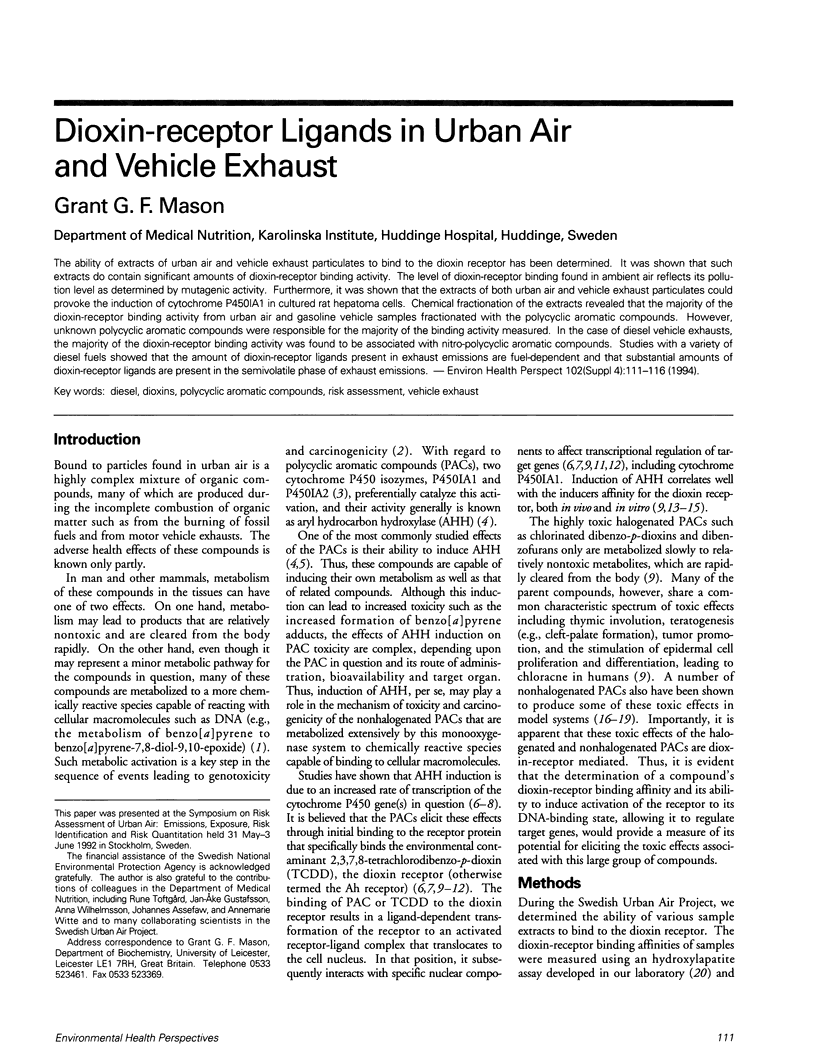
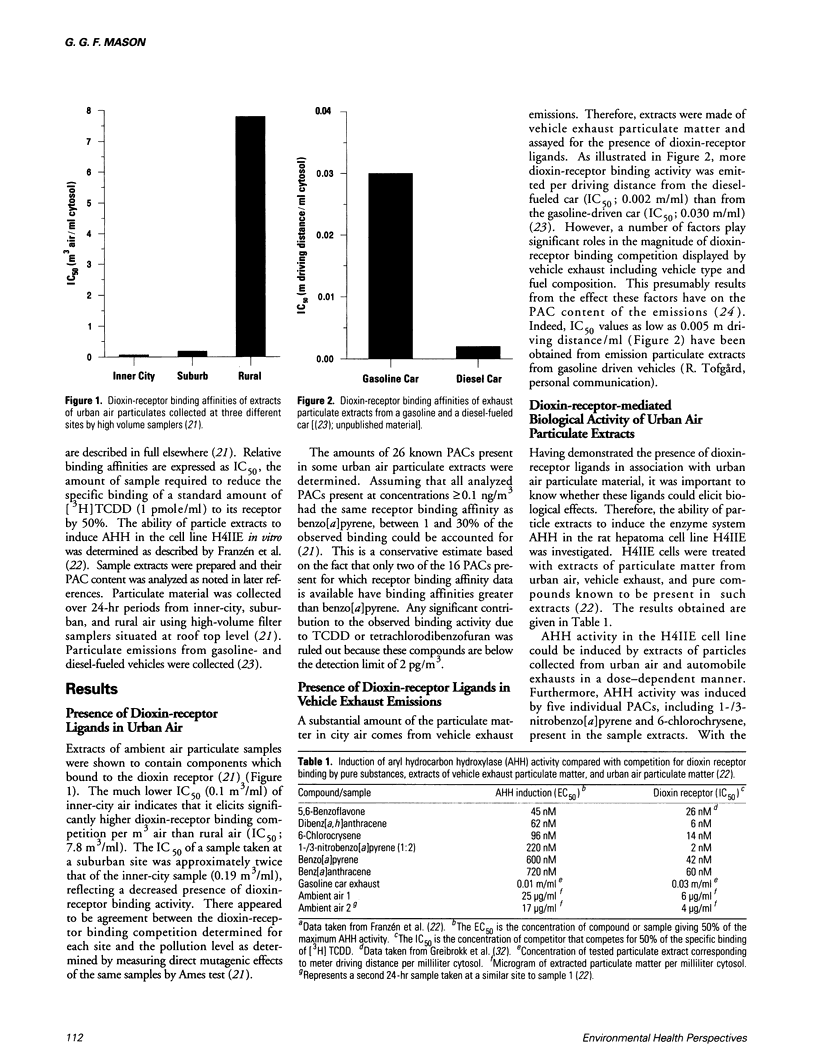
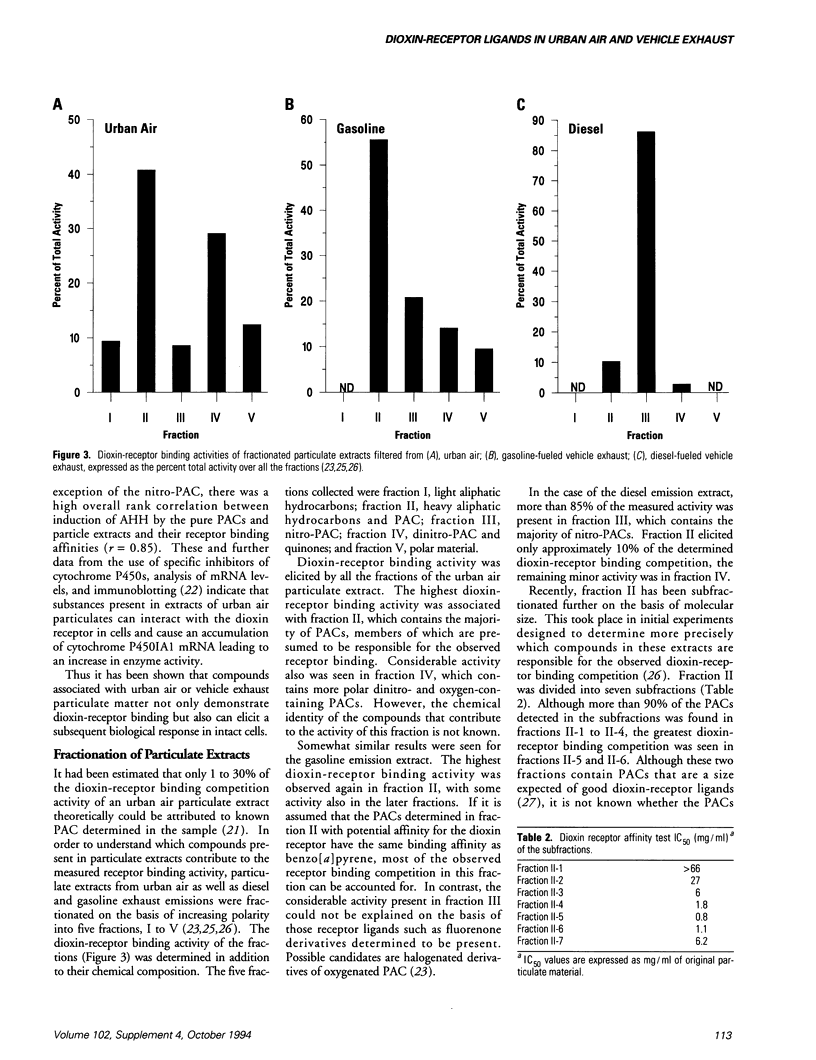
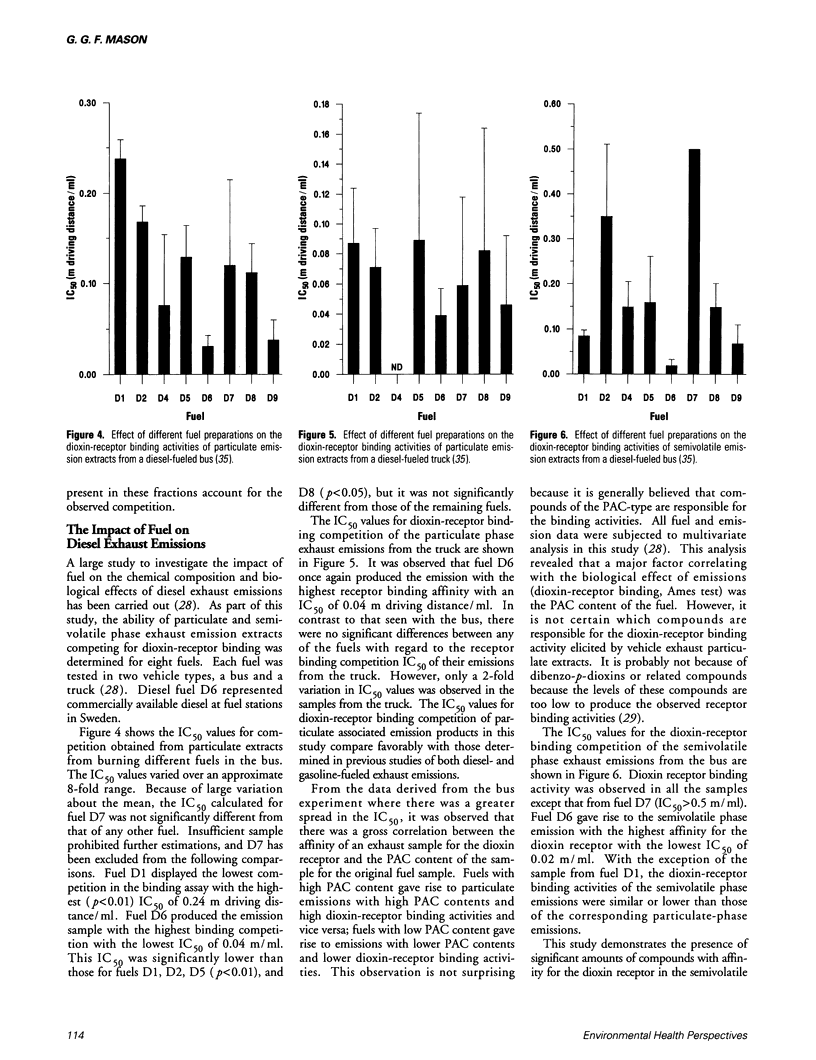
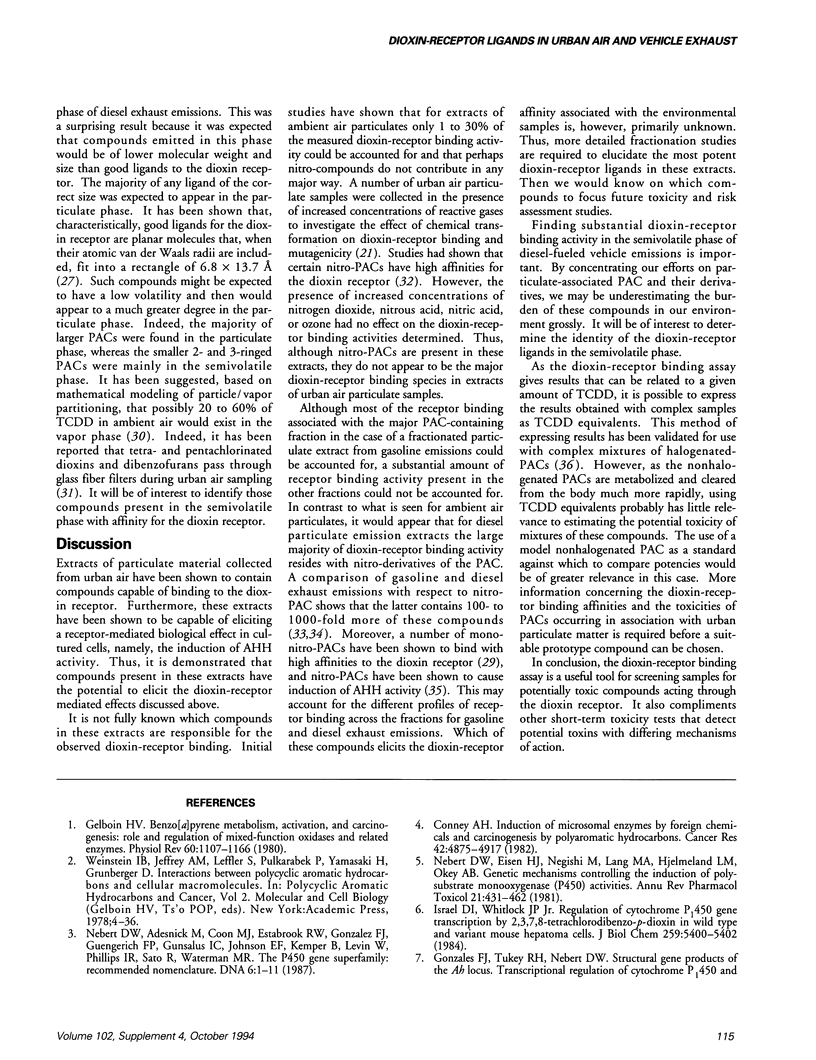

Selected References
These references are in PubMed. This may not be the complete list of references from this article.
- Aström A., Birberg W., Pilotti A., DePierre J. W. Induction of different isozymes of cytochrome P-450 and of microsomal epoxide hydrolase in rat liver by 2-acetylaminofluorene and structurally related compounds. Eur J Biochem. 1986 Jan 2;154(1):125–134. doi: 10.1111/j.1432-1033.1986.tb09367.x. [DOI] [PubMed] [Google Scholar]
- Conney A. H. Induction of microsomal enzymes by foreign chemicals and carcinogenesis by polycyclic aromatic hydrocarbons: G. H. A. Clowes Memorial Lecture. Cancer Res. 1982 Dec;42(12):4875–4917. [PubMed] [Google Scholar]
- Franzén B., Haaparanta T., Gustafsson J. A., Toftgård R. TCDD receptor ligands present in extracts of urban air particulate matter induce aryl hydrocarbon hydroxylase activity and cytochrome P-450c gene expression in rat hepatoma cells. Carcinogenesis. 1988 Jan;9(1):111–115. doi: 10.1093/carcin/9.1.111. [DOI] [PubMed] [Google Scholar]
- Gelboin H. V. Benzo[alpha]pyrene metabolism, activation and carcinogenesis: role and regulation of mixed-function oxidases and related enzymes. Physiol Rev. 1980 Oct;60(4):1107–1166. doi: 10.1152/physrev.1980.60.4.1107. [DOI] [PubMed] [Google Scholar]
- Gillner M., Bergman J., Cambillau C., Fernström B., Gustafsson J. A. Interactions of indoles with specific binding sites for 2,3,7,8-tetrachlorodibenzo-p-dioxin in rat liver. Mol Pharmacol. 1985 Oct;28(4):357–363. [PubMed] [Google Scholar]
- Israel D. I., Whitlock J. P., Jr Regulation of cytochrome P1-450 gene transcription by 2,3,7, 8-tetrachlorodibenzo-p-dioxin in wild type and variant mouse hepatoma cells. J Biol Chem. 1984 May 10;259(9):5400–5402. [PubMed] [Google Scholar]
- Knutson J. C., Poland A. Keratinization of mouse teratoma cell line XB produced by 2,3,7,8-tetrachlorodibenzo-p-dioxin: an in vitro model of toxicity. Cell. 1980 Nov;22(1 Pt 1):27–36. doi: 10.1016/0092-8674(80)90151-8. [DOI] [PubMed] [Google Scholar]
- Mason G., Farrell K., Keys B., Piskorska-Pliszczynska J., Safe L., Safe S. Polychlorinated dibenzo-p-dioxins: quantitative in vitro and in vivo structure-activity relationships. Toxicology. 1986 Oct;41(1):21–31. doi: 10.1016/0300-483x(86)90101-0. [DOI] [PubMed] [Google Scholar]
- Mason G., Sawyer T., Keys B., Bandiera S., Romkes M., Piskorska-Pliszczynska J., Zmudzka B., Safe S. Polychlorinated dibenzofurans (PCDFs): correlation between in vivo and in vitro structure-activity relationships. Toxicology. 1985 Oct;37(1-2):1–12. doi: 10.1016/0300-483x(85)90108-8. [DOI] [PubMed] [Google Scholar]
- Nebert D. W., Adesnik M., Coon M. J., Estabrook R. W., Gonzalez F. J., Guengerich F. P., Gunsalus I. C., Johnson E. F., Kemper B., Levin W. The P450 gene superfamily: recommended nomenclature. DNA. 1987 Feb;6(1):1–11. doi: 10.1089/dna.1987.6.1. [DOI] [PubMed] [Google Scholar]
- Nebert D. W., Eisen H. J., Negishi M., Lang M. A., Hjelmeland L. M., Okey A. B. Genetic mechanisms controlling the induction of polysubstrate monooxygenase (P-450) activities. Annu Rev Pharmacol Toxicol. 1981;21:431–462. doi: 10.1146/annurev.pa.21.040181.002243. [DOI] [PubMed] [Google Scholar]
- Osborne R., Greenlee W. F. 2,3,7,8-Tetrachlorodibenzo-p-dioxin (TCDD) enhances terminal differentiation of cultured human epidermal cells. Toxicol Appl Pharmacol. 1985 Mar 15;77(3):434–443. doi: 10.1016/0041-008x(85)90183-8. [DOI] [PubMed] [Google Scholar]
- Poellinger L., Lund J., Dahlberg E., Gustafsson J. A. A hydroxylapatite microassay for receptor binding of 2,3,7,8-tetrachlorodibenzo-p-dioxin and 3-methylcholanthrene in various target tissues. Anal Biochem. 1985 Feb 1;144(2):371–384. doi: 10.1016/0003-2697(85)90130-7. [DOI] [PubMed] [Google Scholar]
- Poland A., Glover E. 2,3,7,8,-Tetrachlorodibenzo-p-dioxin: segregation of toxocity with the Ah locus. Mol Pharmacol. 1980 Jan;17(1):86–94. [PubMed] [Google Scholar]
- Poland A., Glover E., Kende A. S. Stereospecific, high affinity binding of 2,3,7,8-tetrachlorodibenzo-p-dioxin by hepatic cytosol. Evidence that the binding species is receptor for induction of aryl hydrocarbon hydroxylase. J Biol Chem. 1976 Aug 25;251(16):4936–4946. [PubMed] [Google Scholar]
- Poland A., Knutson J. C. 2,3,7,8-tetrachlorodibenzo-p-dioxin and related halogenated aromatic hydrocarbons: examination of the mechanism of toxicity. Annu Rev Pharmacol Toxicol. 1982;22:517–554. doi: 10.1146/annurev.pa.22.040182.002505. [DOI] [PubMed] [Google Scholar]
- Rheinwald J. G., Green H. Formation of a keratinizing epithelium in culture by a cloned cell line derived from a teratoma. Cell. 1975 Nov;6(3):317–330. doi: 10.1016/0092-8674(75)90183-x. [DOI] [PubMed] [Google Scholar]
- Safe S. H. Comparative toxicology and mechanism of action of polychlorinated dibenzo-p-dioxins and dibenzofurans. Annu Rev Pharmacol Toxicol. 1986;26:371–399. doi: 10.1146/annurev.pa.26.040186.002103. [DOI] [PubMed] [Google Scholar]
- Safe S., Mason G., Sawyer T., Zacharewski T., Harris M., Yao C., Keys B., Farrell K., Holcomb M., Davis D. Development and validation of in vitro induction assays for toxic halogenated aromatic mixtures: a review. Toxicol Ind Health. 1989 Oct;5(5):757–775. doi: 10.1177/074823378900500513. [DOI] [PubMed] [Google Scholar]
- Toftgård R., Löfroth G., Carlstedt-Duke J., Kurl R., Gustafsson J. A. Compounds in urban air compete with 2,3,7,8-tetrachlorodibenzo-p-dioxin for binding to the receptor protein. Chem Biol Interact. 1983 Sep 15;46(3):335–346. doi: 10.1016/0009-2797(83)90017-0. [DOI] [PubMed] [Google Scholar]
- Tukey R. H., Hannah R. R., Negishi M., Nebert D. W., Eisen H. J. The Ah locus: correlation of intranuclear appearance of inducer-receptor complex with induction of cytochrome P1-450 mRNA. Cell. 1982 Nov;31(1):275–284. doi: 10.1016/0092-8674(82)90427-5. [DOI] [PubMed] [Google Scholar]
- Tukey R. H., Nebert D. W., Negishi M. Structural gene product of the [Ah] complex. Evidence for transcriptional control of cytochrome P1-450 induction by use of a cloned DNA sequence. J Biol Chem. 1981 Jul 10;256(13):6969–6974. [PubMed] [Google Scholar]
- Whitlock J. P., Jr The regulation of cytochrome P-450 gene expression. Annu Rev Pharmacol Toxicol. 1986;26:333–369. doi: 10.1146/annurev.pa.26.040186.002001. [DOI] [PubMed] [Google Scholar]


